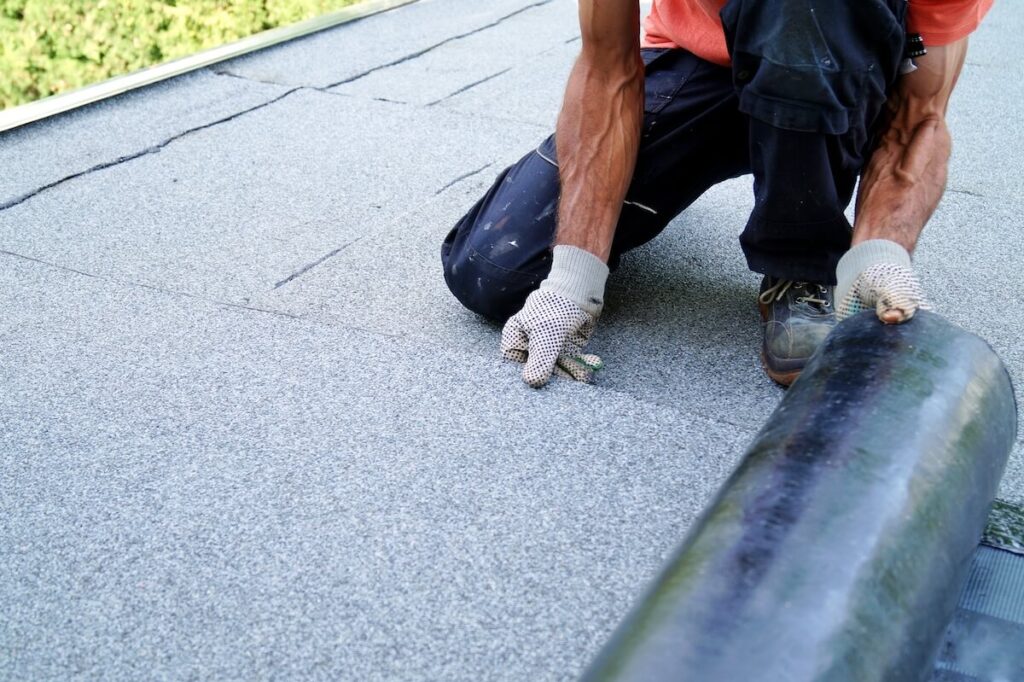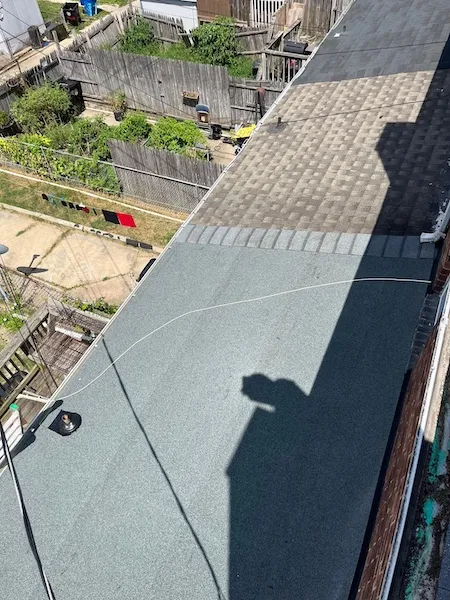When you need a reliable roofing option that balances cost and durability, roll roofing often stands out. It provides quick installation, straightforward maintenance, and solid weather protection for structures that don’t require the lifespan of higher-end flat roofing systems. At RoofPRO, our team has years of experience working with roll roofing on residential and light commercial properties throughout Maryland. It is most commonly used for garages, porches, sheds, and small additions. We’ll walk you through the material’s strengths, its limitations, and why homeowners and business owners continue to choose it for specific projects.

What Is Roll Roofing?
Roll roofing is an asphalt-based roofing material manufactured in long, 3-foot-wide rolls instead of individual shingles. It’s most commonly used on residential structures such as garages, porches, and sheds, but it’s also available for light commercial applications. The material installs in layers, typically consisting of a base sheet and a cap sheet that’s sealed over top.
The cap sheet often includes protective granules—similar to those found on asphalt shingles—which shield the roof from sun damage. These granules can also be tinted in different colors to match a nearby sloped roof or blend with the building’s exterior.
Lifespan depends on how many layers are installed. A basic system with one base sheet and one cap sheet typically lasts 10–12 years, while adding a second base sheet can extend that lifespan up to 20 years. By comparison, single-ply materials like TPO roofing use just one layer but can last 20–30 years, depending on thickness.
Although roll roofing doesn’t offer the same longevity as higher-end flat roofing systems, it remains a practical and affordable option for smaller roofs or secondary structures that need reliable weather protection without the higher investment.
Where it fits:
- Small low-slope structures such as sheds, detached garages, and porch covers.
- Budget-conscious repairs for limited square footage.
- Shorter timeframes where a quick dry-in is helpful.
Where it struggles:
- Roofs that hold standing water after rain.
- Complex roofs with numerous penetrations or curbs.
- Large commercial footprints where single-ply membranes outperform over time.
Roll Roofing vs. Other Flat Roof Materials
Choosing between flat roof options depends on your goals for cost, longevity, and maintenance. Here’s how roll roofing compares:
Roll Roofing vs. Shingles
Asphalt shingles are more attractive and last longer, but they require a steeper slope to shed water properly. Roll roofing is thinner, less decorative, and built for utility. On a flat or low-slope roof, shingles are not recommended. Roll roofing provides a watertight solution that works where shingles cannot.
Roll Roofing vs TPO
Roll roofing is the more affordable choice upfront and works well for smaller residential projects like garages or porches. It’s easy to install and provides solid weather protection for 10–20 years, depending on how many layers are applied. TPO, on the other hand, is a single-ply membrane designed for larger or more permanent flat roofs. It offers superior energy efficiency, UV resistance, and durability, often lasting 20–30 years with minimal maintenance. In short, roll roofing is a cost-effective short-term solution, while TPO is a long-term investment built for lasting performance.
Roll Roofing vs EPDM
EPDM is a rubber membrane available in large sheets. Fewer seams reduce leak risk. It handles temperature swings well. On small projects with many edges, trimming and detailing can take time. If a roof is simple and under 900 to 10,00 square feet, rolled roofing can be a faster service call. For bigger footprints, EPDM’s sheet size helps.
Roll Roofing vs Modified Bitumen
Modified bitumen comes in APP and SBS formulations. It can be torch-applied, cold-applied, or self-adhered. It is thicker than commodity roll roofing and resists punctures better. For many Maryland homes, a self-adhered mod bit cap like CertainTeed Flintlastic SA, GAF Liberty SA, or Mule-Hide SA provides a strong middle ground between price and durability.
Quick Material Comparison Table
System | Typical cost on small areas | Seams | Color options | Typical service life | Good fit |
Mineral roll roofing | Lowest | Cemented or adhesive laps | Mostly granule colors | Shortest | Sheds, small garages, budget repairs |
Self-adhered modified bitumen | Low to mid | Factory adhesive laps | Granule colors | Moderate | Porches, low-slope add-ons |
TPO | Mid | Heat-welded | White or light colors | Moderate to long | Larger low-slope sections, energy focus |
EPDM | Mid | Taped or adhered | Black, some white | Long | Large, simple footprints |
Manufacturers we work with include GAF, CertainTeed, Johns Manville, Mule-Hide, Firestone, and Carlisle. We match products to slope, deck type, and exposure.
Roll Roofing Installation
For roll roofing installation, a clean surface and correct overlaps are more important than anything else. Our crews follow a consistent process that respects manufacturer specs and local building codes.
1) Site Evaluation and Moisture Check
We inspect the current roof covering and decking. If a moisture meter or infrared scan indicates wet substrate, we remove materials to confirm the condition. Soft or rotted decking is replaced. Drains and gutters are checked for clogs so ponding does not return after the new install.
2) Deck Prep and Underlayment
The deck is prepped, seams are tightened, and fasteners are set flush. We prime where the manufacturer requires primer. Underlayment is chosen based on slope and product line. On many small structures, we use a self-adhered base sheet for added water protection and smoother adhesion of the cap roll.
3) Adhesion Method
There are three common methods.
- Cold-applied roofing cement is applied at laps and details for traditional mineral roll.
- Self-adhered systems that use factory adhesive on the sheet. Examples include GAF Liberty SA and CertainTeed Flintlastic SA.
- Torch application for modified bitumen cap sheets when permitted by code and site conditions.
We recommend self-adhered systems for most occupied homes because they deliver strong bonds without open flame and keep fumes lower than many hot applications.
4) Flashing and Edges
Metal edge at eaves and rakes gives the roll a clear termination. Wall transitions receive base flashing and a counter-flashing detail. Penetrations such as pipes and small vents get factory boots or field-built pitch pockets depending on the situation.
5) Seams, Overlaps, and Surfacing
Side laps are set to the manufacturer’s minimum, often 3 inches, and end laps are 6 inches or more with cement or adhesive as specified. Granule-surfaced rolls shed UV and help with light foot traffic. Where maintenance staff may walk, we can add granular walk pads at service routes.
6) Final Inspection and Clean-Up
We check seams, flashings, scuppers, and terminations. Photos document the condition before and after. The crew removes debris and nails, then reviews the warranty and care tips with you.

Benefits of Roll Roofing for Flat Roofs
Cost-Effective Roofing Option
For property owners watching their budget, roll roofing is one of the most affordable choices. Both the material and the labor are less expensive than alternatives like modified bitumen or single-ply membranes. This makes it appealing for detached garages, storage sheds, or small flat-roofed additions.
Quick and Easy Installation
Most roll roofing projects can be completed within a single day. Because the rolls cover wide areas, fewer seams are required, and installation requires less time compared to laying shingles. For homeowners who want a fast solution, this efficiency is a major benefit.
Weather Resistance
When installed properly, roll roofing stands up to rain, moderate wind, and UV exposure. It may not match the durability of higher-end materials, but it still offers dependable protection for structures that don’t demand premium roofing systems.
Versatility for Small Structures
Roll roofing is best suited for smaller applications. Whether you’re covering a garden shed, carport, workshop, or porch, it delivers protection without unnecessary costs. Homeowners across Maryland often use it for outbuildings or flat roof extensions where higher-end roofing would exceed the value of the structure itself.
How Long Does Roll Roofing Last?
On average, roll roofing lasts between 5 and 10 years. The exact lifespan depends on several factors:
- Quality of installation
- Roof slope and drainage
- Level of maintenance
- Exposure to direct sunlight and harsh weather
Because roll roofing is thinner than other materials, it is more prone to wear and tear. Small tears, lifting seams, or punctures can reduce its lifespan. That’s why regular inspections and timely repairs are important if you want to get the most out of the system.
For homeowners who need a short-term solution, roll roofing fills the gap. For long-term peace of mind, RoofPRO can recommend alternatives such as modified bitumen, TPO, or metal panels.
Warranties, Financing, and Scheduling
RoofPRO backs workmanship with a written warranty. Product warranties vary by brand and assembly. We explain how wind coverage, substrate requirements, and maintenance affect terms so there are no surprises later.
- Maintenance plans are available: A spring and fall inspection keeps seams and drains in shape. We provide photos and a short report with any recommended tune-ups.
- Financing is available for qualified customers: Many small roll roofing projects can be completed with modest monthly payments. Ask our team for today’s programs and approvals.
- Scheduling is flexible: Many small structures can be completed in one day, weather permitting. You get an arrival window, a point of contact on site, and a clean-up checklist at closeout.
Schedule a Roll Roofing Estimate with RoofPRO
If you’re considering roll roofing for your garage, shed, or flat roof addition, RoofPRO can help. Our team installs, repairs, and maintains roll roofing across Maryland, providing affordable solutions without sacrificing quality. We’ll walk you through your options, give you a clear estimate, and help you decide whether roll roofing or another system is the right choice for your property.
Call RoofPRO today or request a free estimate through our website to get started on your roll roofing project.


